AI Detection
Undetectable AI is Not Undetectable
Artificial Intelligence (AI) has revolutionized the field of content creation, marking a significant shift in how content is generated, personalized, and distributed. In the current digital era, AI technologies such as GPT (Generative Pre-trained Transformer) have empowered creators with tools that can produce written content, images, music, and even video content at an unprecedented scale and speed. This transformation is not limited to enhancing productivity and creativity but also extends to personalizing user experiences on platforms through AI-curated content feeds. AI-driven content creation tools are designed to understand and mimic human creativity, making it easier for businesses, educators, marketers, and artists to generate original content tailored to their specific needs. This leap in technology has democratized content creation, enabling individuals and organizations with limited resources to produce high-quality content that can compete with traditionally created content.However, the surge in AI-generated content has also led to the emergence of AI detectors, tools specifically designed to discern between content created by humans and AI. As AI-generated content becomes more sophisticated, distinguishing between human and AI-generated texts or images becomes increasingly challenging, raising concerns about authenticity, copyright, and misinformation. In response to these concerns, AI detector tools have been developed to help verify the origin of content. Yet, the evolution of technology is a two-sided coin; alongside AI detectors, there are now tools like Undetectable AI and StealthGPT aimed at bypassing these detectors. These AI detector bypass tools are engineered to refine AI-generated content in such a way that it mimics human-like imperfections or nuances, making detection significantly more difficult. This cat-and-mouse game between AI content creation and detection highlights the complex interplay between innovation and regulation in the digital age, underscoring the need for ongoing advancements in ethical standards and technological solutions to address the challenges posed by AI in content creation.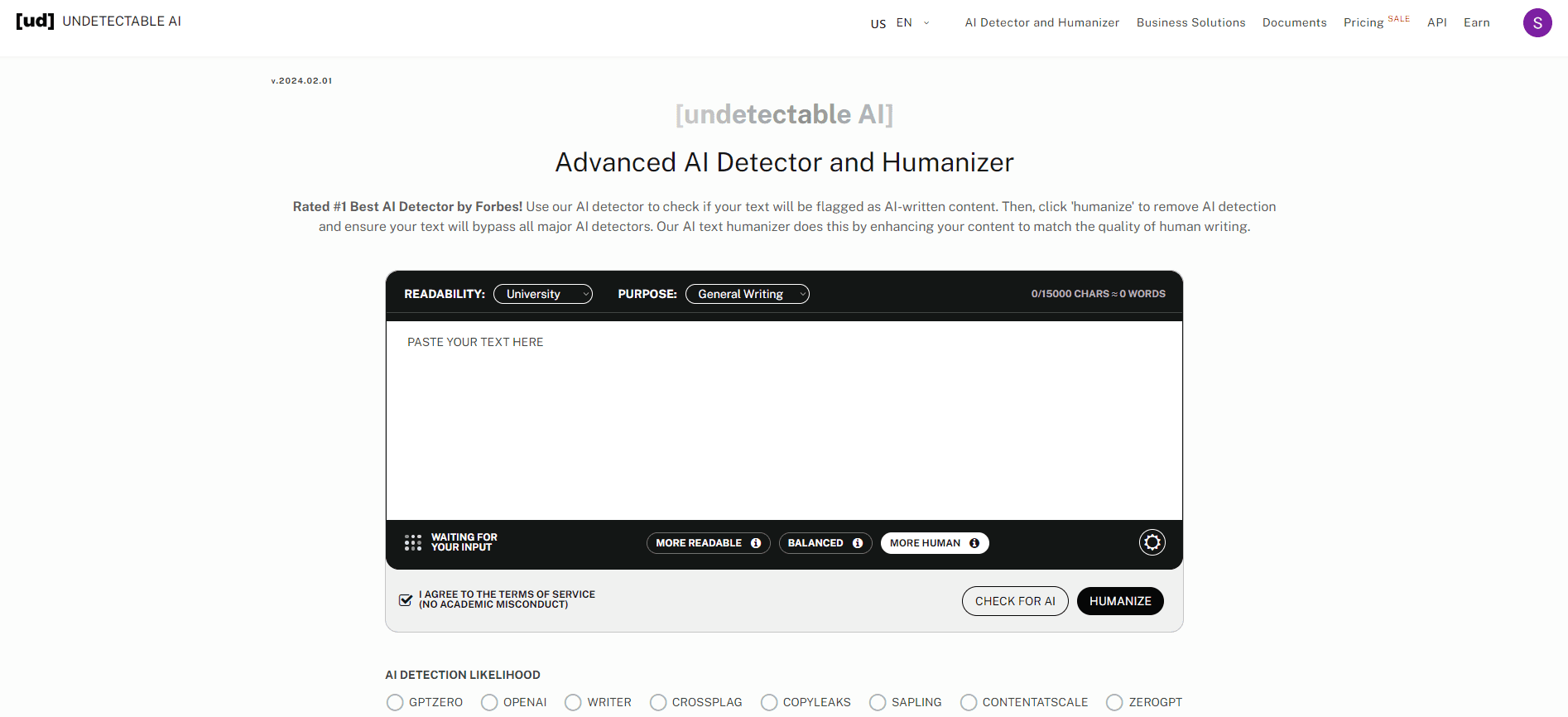 Undetectable AI is a cutting-edge tool designed to generate text that can bypass AI detection systems, which are increasingly used to differentiate between human-written and AI-generated content. At its core, Undetectable AI employs sophisticated machine learning algorithms and natural language processing (NLP) techniques to produce content that closely mimics human writing styles, nuances, and idiosyncrasies. This capability is particularly significant in an era where the authenticity of digital content is scrutinized, and the distinction between human and AI-created content can have ethical, legal, and societal implications. The technology behind Undetectable AI is built on advanced models that are trained on vast datasets of human writing, enabling it to understand and replicate the variability and complexity inherent in human language. It analyzes patterns in sentence structure, word choice, and stylistic elements that are characteristic of human writing, adjusting its output to evade detection algorithms that are designed to spot the telltale signs of AI generation.The innovation in Undetectable AI's approach lies not only in its ability to produce content that appears human-made but also in its continuous learning capability. As AI detectors evolve and become more sophisticated, Undetectable AI dynamically adjusts its strategies based on feedback and new data, enhancing its evasion techniques. This is achieved through a process of adversarial training, where the system is repeatedly tested against the latest detection models to identify any features that could betray its non-human origin. By refining its methods through this ongoing adversarial process, Undetectable AI ensures that its generated content remains one step ahead of detection technologies. This approach exemplifies the cutting-edge application of AI in mimicking human creativity and intelligence, highlighting the intricate dance between technological advancement and the pursuit of authenticity in digital content.
Undetectable AI is a cutting-edge tool designed to generate text that can bypass AI detection systems, which are increasingly used to differentiate between human-written and AI-generated content. At its core, Undetectable AI employs sophisticated machine learning algorithms and natural language processing (NLP) techniques to produce content that closely mimics human writing styles, nuances, and idiosyncrasies. This capability is particularly significant in an era where the authenticity of digital content is scrutinized, and the distinction between human and AI-created content can have ethical, legal, and societal implications. The technology behind Undetectable AI is built on advanced models that are trained on vast datasets of human writing, enabling it to understand and replicate the variability and complexity inherent in human language. It analyzes patterns in sentence structure, word choice, and stylistic elements that are characteristic of human writing, adjusting its output to evade detection algorithms that are designed to spot the telltale signs of AI generation.The innovation in Undetectable AI's approach lies not only in its ability to produce content that appears human-made but also in its continuous learning capability. As AI detectors evolve and become more sophisticated, Undetectable AI dynamically adjusts its strategies based on feedback and new data, enhancing its evasion techniques. This is achieved through a process of adversarial training, where the system is repeatedly tested against the latest detection models to identify any features that could betray its non-human origin. By refining its methods through this ongoing adversarial process, Undetectable AI ensures that its generated content remains one step ahead of detection technologies. This approach exemplifies the cutting-edge application of AI in mimicking human creativity and intelligence, highlighting the intricate dance between technological advancement and the pursuit of authenticity in digital content.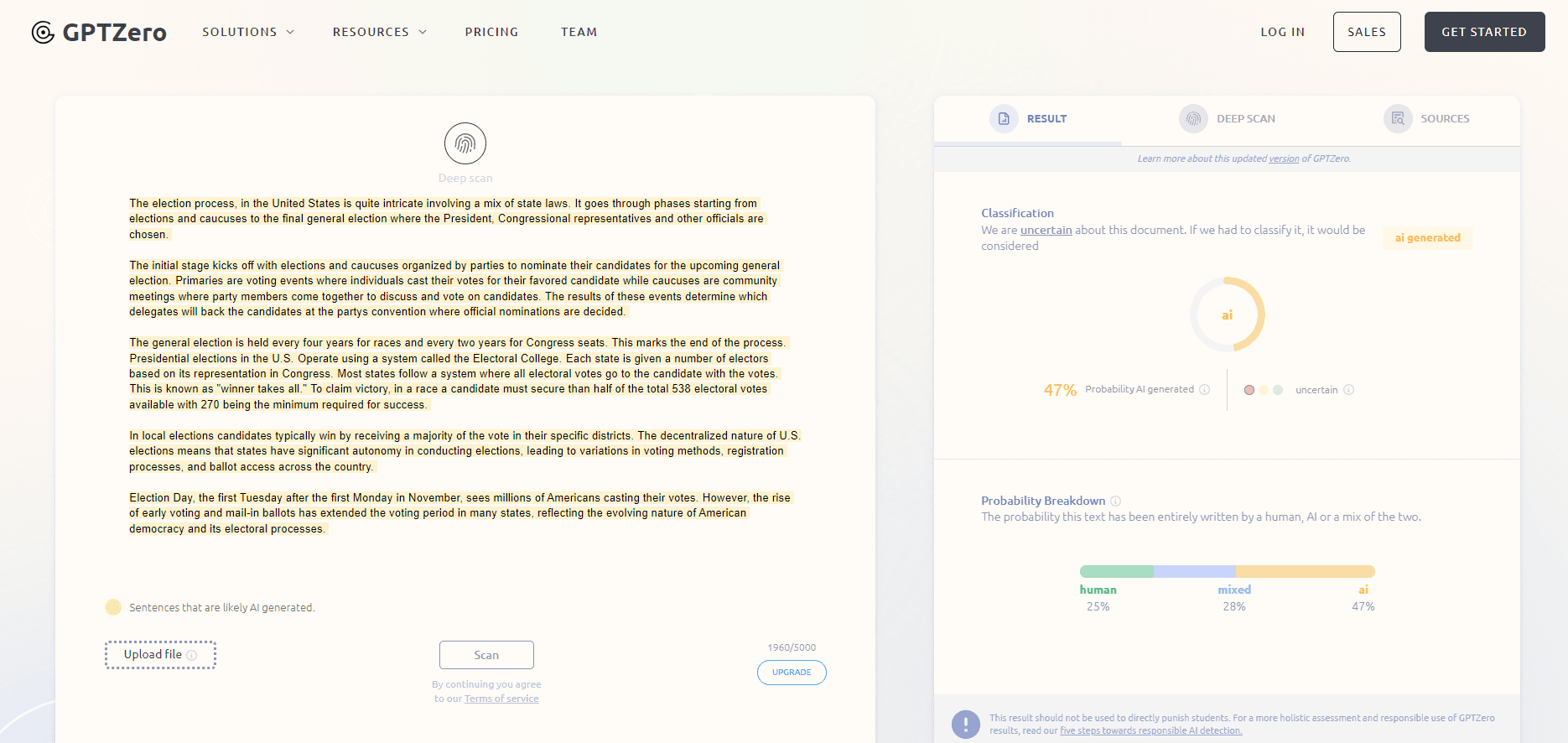 In our latest assessment, we scrutinized the effectiveness of Undetectable AI, a platform that purports to create AI-generated text that seamlessly blends in with content written by humans, allegedly evading detection by tools such as GPTZero. Despite its bold claims, the content processed through Undetectable AI received a 47% AI-written score, indicating it was recognized as AI-generated. This result starkly contradicts the platform's assurances of providing an infallible method for producing content that detection algorithms cannot distinguish from human writing. Such findings bring into question the platform's capability and the precision of its technology in accurately emulating human writing nuances.Undetectable AI vs Scribbr Results
In our latest assessment, we scrutinized the effectiveness of Undetectable AI, a platform that purports to create AI-generated text that seamlessly blends in with content written by humans, allegedly evading detection by tools such as GPTZero. Despite its bold claims, the content processed through Undetectable AI received a 47% AI-written score, indicating it was recognized as AI-generated. This result starkly contradicts the platform's assurances of providing an infallible method for producing content that detection algorithms cannot distinguish from human writing. Such findings bring into question the platform's capability and the precision of its technology in accurately emulating human writing nuances.Undetectable AI vs Scribbr Results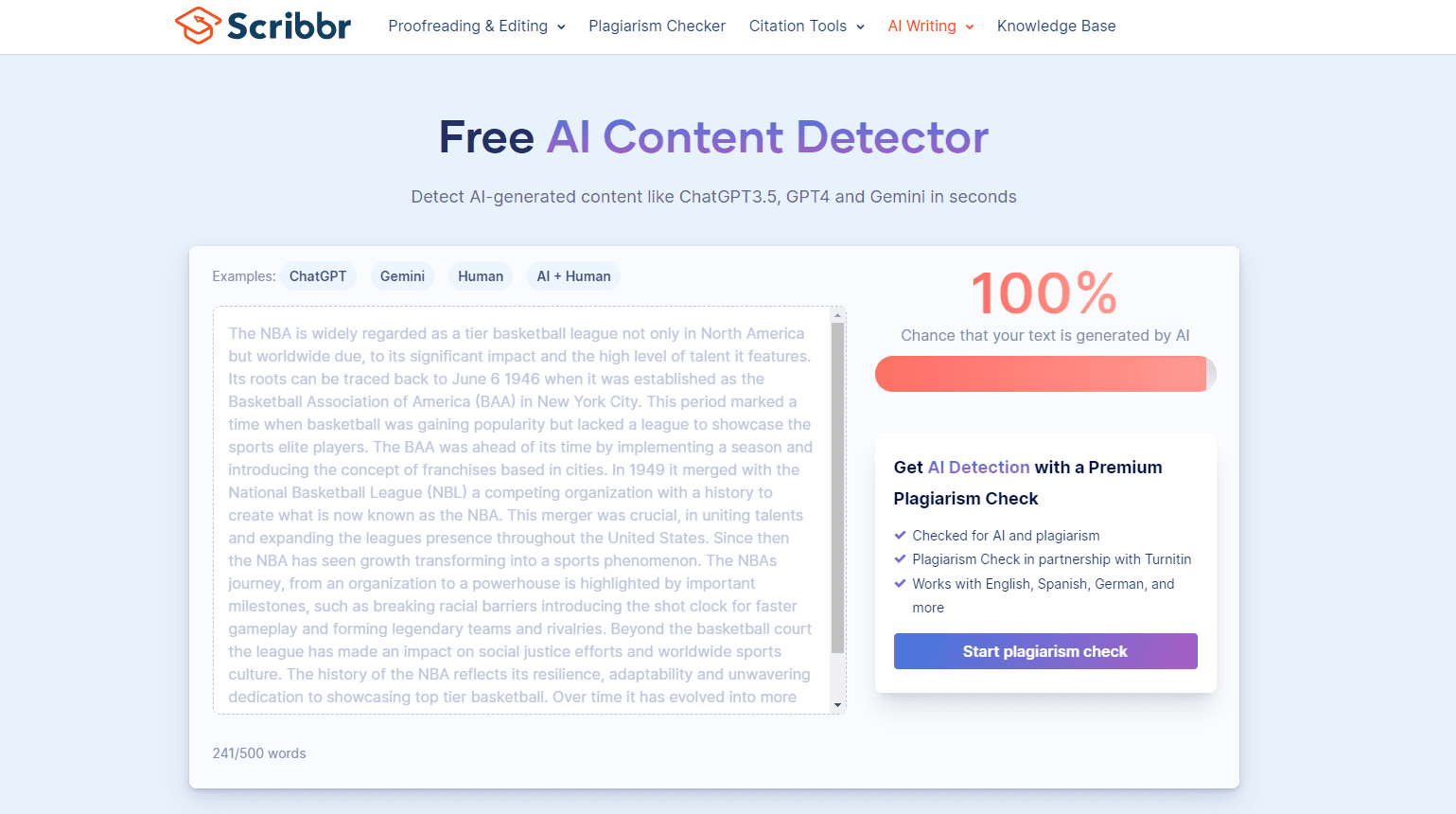 Scribbr, a platform celebrated for its commitment to academic integrity through its sophisticated AI and plagiarism detection tools, recently put Undetectable AI to the test. The verdict was clear: Scribbr's advanced detection system classified the text as entirely AI-generated, marking it with a 100% AI-generated score. This revelation not only exposes the shortcomings of Undetectable AI's technology in fooling modern detection systems but also highlights the advanced capabilities of Scribbr's detection techniques. Such results cast a shadow over the potential for current technologies to fully bypass detection by cutting-edge software, questioning the efficacy of efforts to make AI-generated content indistinguishable from that written by humans.Undetectable AI vs Originality AI Results
Scribbr, a platform celebrated for its commitment to academic integrity through its sophisticated AI and plagiarism detection tools, recently put Undetectable AI to the test. The verdict was clear: Scribbr's advanced detection system classified the text as entirely AI-generated, marking it with a 100% AI-generated score. This revelation not only exposes the shortcomings of Undetectable AI's technology in fooling modern detection systems but also highlights the advanced capabilities of Scribbr's detection techniques. Such results cast a shadow over the potential for current technologies to fully bypass detection by cutting-edge software, questioning the efficacy of efforts to make AI-generated content indistinguishable from that written by humans.Undetectable AI vs Originality AI Results In our latest examination, we utilized Originality AI, a platform known for its ability to identify AI-generated content, to evaluate the outputs from Undetectable AI. This test was aimed at verifying the claims made by Undetectable AI about its proficiency in creating content that could pass as human-written, thereby eluding AI detection mechanisms. The findings were quite revealing, with Originality AI attributing a 100% AI-generated score to the texts produced by Undetectable AI. Such a definitive outcome clearly demonstrates that the content was detected as being fully generated by AI, highlighting a notable gap in Undetectable AI's ability to bypass the detection capabilities of advanced tools like Originality AI.
In our latest examination, we utilized Originality AI, a platform known for its ability to identify AI-generated content, to evaluate the outputs from Undetectable AI. This test was aimed at verifying the claims made by Undetectable AI about its proficiency in creating content that could pass as human-written, thereby eluding AI detection mechanisms. The findings were quite revealing, with Originality AI attributing a 100% AI-generated score to the texts produced by Undetectable AI. Such a definitive outcome clearly demonstrates that the content was detected as being fully generated by AI, highlighting a notable gap in Undetectable AI's ability to bypass the detection capabilities of advanced tools like Originality AI.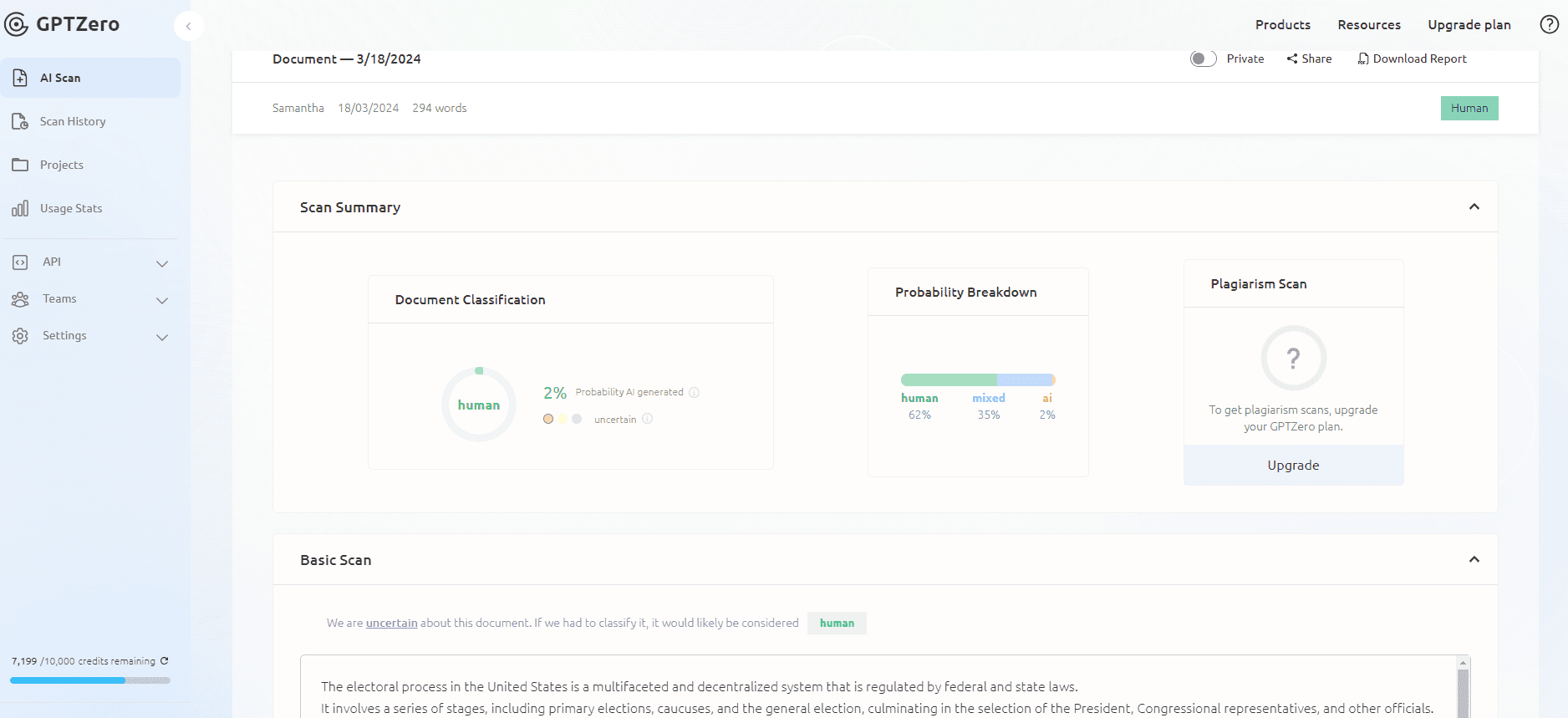
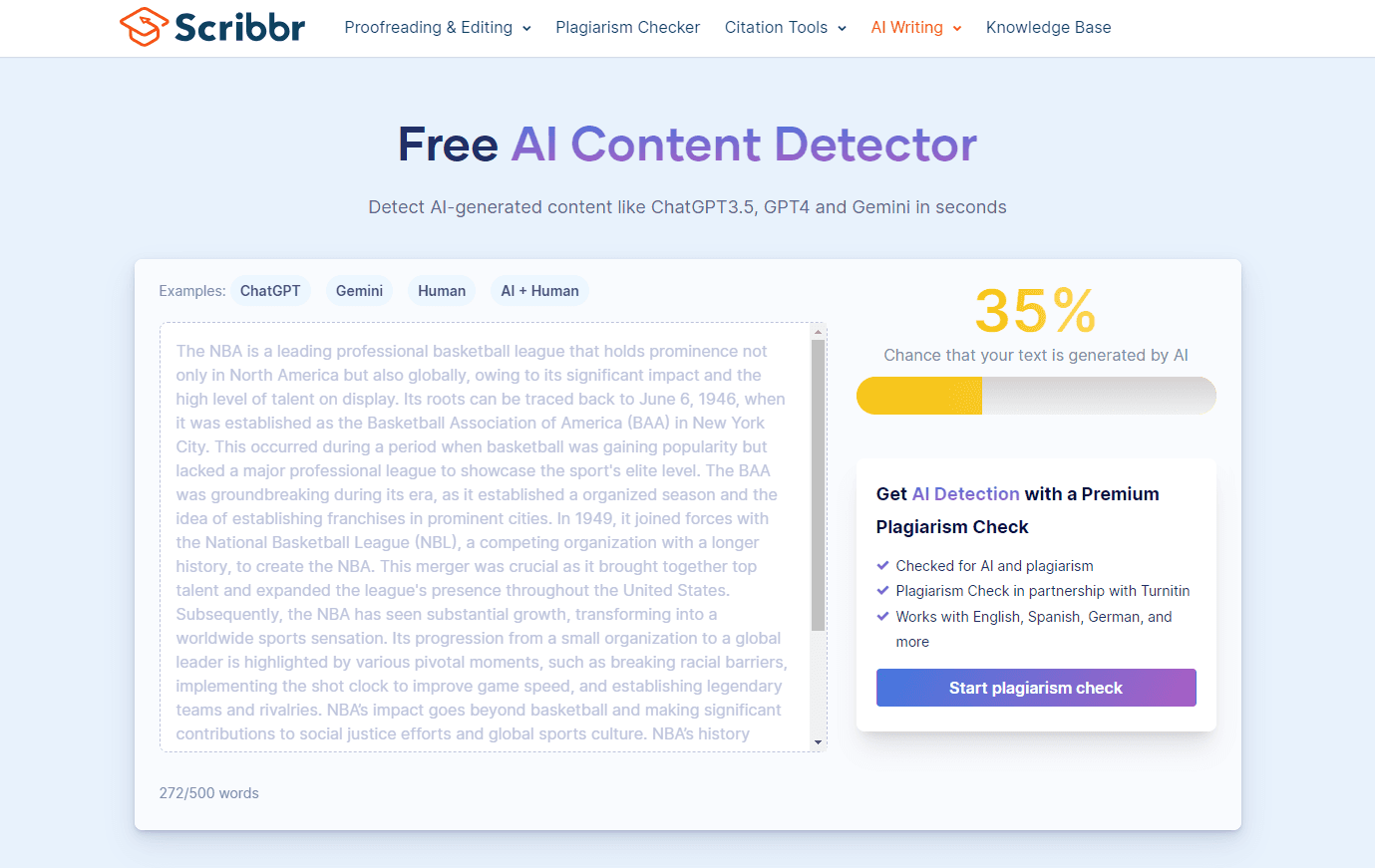
 StealthGPT has remarkably proven its prowess in evading AI detection mechanisms across various platforms, demonstrating an uncanny ability to mimic human writing styles. In a series of tests against renowned AI detection tools such as GPTZero, Scribbr, and Originality AI, StealthGPT's outputs were consistently perceived with low probabilities of being AI-generated. GPTZero's analysis suggested a mere 2% chance of AI authorship, while Scribbr assigned a low AI-generated score of just 35%, vastly outperforming Undetectable AI in similar conditions. Most impressively, StealthGPT's content was deemed 100% human-generated by Originality AI, marking a significant milestone in AI content creation. These results not only underscore StealthGPT's advanced algorithmic capabilities in producing content that closely aligns with human writing but also highlight its significant edge in the realm of undetectable AI-generated content, setting a new benchmark in the field and showcasing the potential for AI to create high-quality, authentic-seeming text.
StealthGPT has remarkably proven its prowess in evading AI detection mechanisms across various platforms, demonstrating an uncanny ability to mimic human writing styles. In a series of tests against renowned AI detection tools such as GPTZero, Scribbr, and Originality AI, StealthGPT's outputs were consistently perceived with low probabilities of being AI-generated. GPTZero's analysis suggested a mere 2% chance of AI authorship, while Scribbr assigned a low AI-generated score of just 35%, vastly outperforming Undetectable AI in similar conditions. Most impressively, StealthGPT's content was deemed 100% human-generated by Originality AI, marking a significant milestone in AI content creation. These results not only underscore StealthGPT's advanced algorithmic capabilities in producing content that closely aligns with human writing but also highlight its significant edge in the realm of undetectable AI-generated content, setting a new benchmark in the field and showcasing the potential for AI to create high-quality, authentic-seeming text.
Table of Contents
- Background
- What is Undetectable AI?
- Undetectable AI Claims
- Debunking Undetectable AI Claims
- Undetectable AI Tests
- Showcasing StealthGPT’s Capabilities
- Conclusion
What is Undetectable AI?

Undetectable AI Claims
Undetectable AI makes bold claims about its capability to bypass a variety of AI detectors, positioning itself as a highly effective tool in the realm of AI-generated content that can elude the scrutiny of advanced detection technologies. According to the developers behind Undetectable AI, their system is engineered to produce content that defies the traditional markers which AI detectors rely on to distinguish between human and machine-generated texts. These claims rest on the tool's innovative use of machine learning algorithms and natural language processing techniques, which enable it to closely mimic human writing patterns, including the intricacies and stylistic nuances characteristic of individual authors.The essence of Undetectable AI's claims is its ability to adapt to and overcome the detection strategies employed by leading AI detection tools. This includes evading both statistical analysis methods, which might analyze patterns such as sentence length, word frequency, and syntax complexity, and more advanced semantic analysis techniques, which attempt to discern the depth of understanding and context behind the content. Undetectable AI asserts that it continuously updates its evasion strategies in response to the evolving landscape of AI detection technologies, thereby ensuring its effectiveness against a broad spectrum of detectors. By doing so, Undetectable AI challenges the capabilities of content authenticity tools and sparks a dynamic, ongoing competition between AI content creators and detectors, highlighting the rapid pace of innovation in the field of artificial intelligence.Debunking Undetectable AI Claims
In our dedicated effort to evaluate the capabilities of Undetectable AI, particularly its claim to bypass AI detectors effectively, we embarked on a detailed testing procedure. We initiated this by generating content through ChatGPT, which was then processed through Undetectable AI in an attempt to "humanize" it further, making it ostensibly indistinguishable from content written by humans. Our objective was to assess how well Undetectable AI could live up to its claims against some of the most prominent AI detection tools available today, including GPTZero, Scribbr, and Originality.AI. These tools are not only widely recognized for their effectiveness but are also extensively used by a diverse user base that includes educators, content creators, and various organizations aiming to ensure the authenticity of the content they use or produce. By utilizing these detection tools in our tests, we sought to cover a broad spectrum of AI detection capabilities, providing a comprehensive overview of Undetectable AI's performance.The results of our tests were aimed at debunking the bold claims made by Undetectable AI about its ability to seamlessly bypass AI detection systems. Despite the advanced techniques purported by Undetectable AI to mimic human writing patterns and evade detection, our findings present a critical examination of these claims. Through systematic testing against GPTZero, Scribbr, and Originality.AI, we gathered conclusive evidence that challenges the effectiveness of Undetectable AI in its current state. The outcomes serve as a testament to the sophistication and adaptability of today's AI detection technologies, highlighting their capacity to discern between human-generated and AI-enhanced content, even when the latter is designed to mimic human nuances closely. These results not only shed light on the limitations of current AI-generated content bypass mechanisms but also emphasize the ongoing need for innovation and ethical considerations in the development of AI content creation and detection tools.Undetectable AI Tests
Undetectable AI vs GPTZero Results


Showcasing StealthGPT’s Capabilities
StealthGPT is an advanced AI tool crafted with the explicit aim of generating content that can bypass the sophisticated detection mechanisms employed by various AI detectors. It leverages cutting-edge techniques in machine learning and natural language processing to produce text that closely mimics the nuances, tone, and style of human writing. The developers of StealthGPT claim it to be a step ahead in the realm of AI-generated content, offering users the ability to create writings that are not only high in quality but also indistinguishable from content penned by humans. This technology promises to bridge the gap between AI and human creativity, providing a solution for those seeking to use AI for content creation without the usual flags raised by AI detection tools.To assess the veracity of these claims, StealthGPT was subjected to the same rigorous testing regimen as Undetectable AI, utilizing prominent AI detection tools such as GPTZero, Scribbr, and Originality AI. The results were illuminating. Unlike Undetectable AI, StealthGPT demonstrated a remarkable ability to evade detection, consistently producing content that was either undetected or scored significantly lower on the AI-generated scale. These outcomes provide compelling evidence of StealthGPT's advanced capabilities in crafting content that mirrors human writing so closely that it challenges the detection boundaries of current AI detectors. Such success not only validates the claims made by StealthGPT's creators but also highlights the ongoing evolution and sophistication of AI in content creation, pushing the limits of what's possible in the increasingly blurred line between human and machine-generated creativity.


